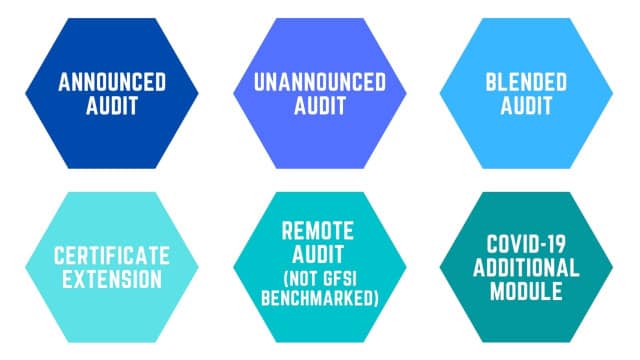Food Safety Challenges
So this pandemic that started in March 2020 has really disrupted the lives of everyone, but one thing that hasn’t changed is the need for food safety. Food safety is a priority for customers, specifiers, brand owners and ultimately for consumers.
The challenges that the pandemic brought about were immediate. They occurred very rapidly, they were mostly unknown and they are ever changing. The word, unprecedented, was used a lot over the last year and it was no different in food safety. It was new territory for everyone involved in the food safety chain.
So the new challenges faced by food business operations included supply chain disruptions amongst other things, but it was actually people that were most affected and the importance of staff health was upmost. One major problem for businesses was the lack of staff availability due to staff illnesses, staff self-isolating, a lack of appropriate PPE and staff needing to organise child-care and home schooling.
In fact the lack of PPE was a major issue as there simply wasn’t enough to go around, and businesses couldn’t get it ordered and delivered quick enough. These kinds of issues were impacting sites and their food safety during this pandemic. Even problems with staff getting to work with restrictions in local and national travel, and especially international travel.
So there was a lot of uncertainty over how food sites were supposed to maintain standards. How do you deal with restrictions on who is an essential worker and who is not. Especially when these restrictions and changing all the time, and are different in different regions and dependant on what part of the country you are in.
This has lead to much confusion and some delays and disruption but of course the demand from the public was increasingly for safe food, especially in the retail sector. The pandemic also affected the ability of some prerequisite services to operate like pest control, waste disposal and cleaning agencies. They were in huge demand but with staff on furlough and other challenges the supply chains were challenged.
So the pandemic has created a very clear prerequisite for all of us and that is adapt how you operate your business or risk losing your business altogether. With all of that going on how were you expected to ensure effective oversight of your food safety management system when resources were compromised or, another way of looking at it, with less staff on site how do you ensure that your food safety systems are not at risk.
We know thousands of sites demonstrate their commitment to food safety by getting certificated to a GFSI scheme such as the BRC global food standard and maintaining that certification during the pandemic was not without its challenges.
We have observed over the last 12 months how businesses have adapted to ensure they have maintained food safety and maintained their certification during the pandemic. There are many lessons to be learned from this pandemic and there is still more to be encountered as the pandemic continues its course so of course, these lessons cannot all be covered in this article.
Just focussing on five main areas of discussion, the first is talking about how BRCGS adapted their approach to auditing to ensure all sites had options to maintain their certification where possible. Also going to talk about the use of ICT and digital platforms to help make the audit process feasible for both sites and auditors. We will also take one of the prerequisites, Pest Control Management and discuss some feedback that we had from two pest control companies on their lessons learned and then we can mention briefly some of the known conformances raised during the pandemic just to understand if we’re seeing differences across sites as a result of the new audit approach that were taken at BRCGS. Finally we can discuss the importance of having contingencies for training when face-to-face training is not possible.
In the face of all this, BRCGS adapted their approach to auditing to give sites a set of options to maintain their certification. There was also some good feedback received from the auditors and certification bodies which I will talk about too. BRCGS launched a suite of audit options that took in to account a number of issues like the GFSI’s position and requirements, the account brand, the retailer feedback, the ever changing and evolving local restrictions, and auditor availability. The maturity and the history of the site’s certification was also taken into account.
The following image shows the audit options available to businesses during the pandemic.

Announced audits still continue to be used where it is possible for an auditor to conduct an on site audit. One thing that was learned very early on in the pandemic though was that unannounced audits were in fact an unnecessary burden on sites and they actually increased the challenges of both the certification bodies and auditors in arranging the audits. So BRCGS took the decision to temporarily suspend the unannounced audit program until at least the end of 2021. Where this happens the certification body will contact the site to arrange either an announced audit or blended audit. BRCGS will keep this temporary suspension under review and hope to restart unannounced audits as soon as possible. Sites will be given at least 3 months notice before they can be offered this option but if a site really needs an unannounced audit this can be carried out by exception. For example, if a customer requirement insists upon it or if perhaps it is part of a combined audit with another standard.
The blended audit can be carried out where an on-site visit is possible, but only for existing sites. This blended audit approach consists of 2 parts. The online remote assessment of some or all of the documents plus the shorter on site assessment. This requires a reduced amount of time for the auditor to be on site. This works well when an auditor can visit a country or region for a short amount of time before having to quarantine. This blended audit option will remain in the future for announced audits.
Where access to the site is not possible and the audit is due, the certificate extension could apply. There must be an existing valid certificate in place and this can be extended by 6 months based upon a risk assessment and review by the certification body. It is based on the controls that are already shown to be in place on the site.
Next option on the list is the full remote audit, which is not GFSI benchmarked. This is available for sites where the certificate extension has expired but it is still not possible for a visit to take place by an auditor due to Covid restrictions. It could also be used if a site does not need a GFSI recognized certificate. It involves a complete review of internal audit documents and usually a video audit of production and storage facilities.
Finally the BRCGS also offer a Covid-19 additional module and have published a separate assessment standard and may be used to provide assurances around the management of Covid-19 risks. It’s carried out like a remote audit and focuses on the areas of the food safety system which are potentially at a greater risk as a result of the changes forced to address over covert 19.
BRCGS offers plenty of options to allow sites and certification bodies to work together to ensure food safety assurances are still in place during the pandemic. However in order for these options, especially the remote and blended options, to be successful sites had to adapt their approach to the audit.
In the next article in this series we will be talking about some of the obstacles and issues that had to be addressed to carry out the various audit options available, and feedback on these from both the sites and auditors.

